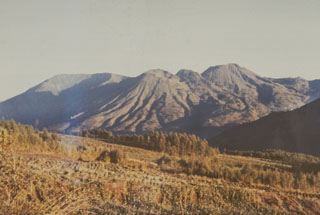Report on Dieng Volcanic Complex (Indonesia) — July 2003
Bulletin of the Global Volcanism Network, vol. 28, no. 7 (July 2003)
Managing Editor: Edward Venzke.
Dieng Volcanic Complex (Indonesia) Mud bubbling and outflows at Sileri crater that reached 50 m beyond crater rim
Please cite this report as:
Global Volcanism Program, 2003. Report on Dieng Volcanic Complex (Indonesia) (Venzke, E., ed.). Bulletin of the Global Volcanism Network, 28:7. Smithsonian Institution. https://doi.org/10.5479/si.GVP.BGVN200307-263200
Dieng Volcanic Complex
Indonesia
7.2°S, 109.879°E; summit elev. 2565 m
All times are local (unless otherwise noted)
According to the Volcanological Survey of Indonesia (VSI), on 20 July 2003 mud poured from Sileri crater. The crater contains a lake and boiling mud pots, and has been the site of small-to-moderate historical eruptions. The incident of 20 July occurred at night and sent mud as far as 25 m S of the crater rim. On 21 July, a temperature measurement of the crater recorded 74°C, no striking increase from earlier measurements.
On the morning of 24 July, another mud outpouring from the crater covered an area up to 50 m N and E of the crater rim. Activity then continued with small areas of mud bubbling and ejecta thrown 1 m high at the middle of the crater. Neither of the mud-outpouring events were recorded on the seismometer 1.1 km S of the crater. The volcano's hazard status was raised to level 2 on 22 July.
Geological Summary. The Dieng plateau in the highlands of central Java is renowned both for the variety of its volcanic scenery and as a sacred area housing Java's oldest Hindu temples, dating back to the 9th century CE. The Dieng Volcanic Complex consists of multiple stratovolcanoes and more than 20 small Pleistocene-to-Holocene craters and cones over a 6 x 14 km area. Prahu stratovolcano was truncated by a large Pleistocene caldera, which was subsequently filled by a series of cones, lava domes, and craters, many containing lakes. Lava flows cover much of the plateau, but observed activity has been restricted to minor phreatic eruptions. Gas emissions are a hazard at several craters and have caused fatalities. There are abundant thermal features and high heat flow across the area.
Information Contacts: Dali Ahmad, Volcanological Survey of Indonesia (VSI), Jalan Diponegoro No. 57, Bandung 40122, Indonesia (URL: http://www.vsi.esdm.go.id/).

